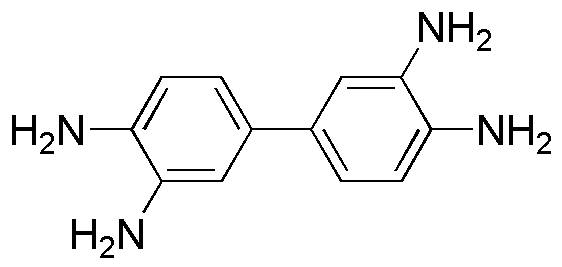3,3'-Diaminobenzidine is widely utilized in research focused on:
- Immunohistochemistry: This compound serves as a chromogenic substrate for peroxidase enzymes, enabling the visualization of specific proteins in tissue samples. It is crucial in diagnosing diseases like cancer by highlighting abnormal cell structures.
- Polymer Chemistry: It is used in the synthesis of polybenzimidazole and other polymers, which are known for their thermal stability and chemical resistance. This makes them suitable for high-performance applications in aerospace and automotive industries.
- Electrochemical Sensors: 3,3'-Diaminobenzidine is employed in the fabrication of electrochemical sensors for detecting various analytes, including glucose and environmental pollutants, due to its excellent conductivity and stability.
- Textile Industry: The compound acts as a dye in textile applications, providing vibrant colors and excellent fastness properties, which are essential for producing durable and high-quality fabrics.
- Research in Neurobiology: It is utilized in tracing neuronal pathways in brain studies, helping researchers understand complex neural networks and their functions, which is vital for advancing neuroscience.
General Information
Properties
Safety and Regulations
Applications
3,3'-Diaminobenzidine is widely utilized in research focused on:
- Immunohistochemistry: This compound serves as a chromogenic substrate for peroxidase enzymes, enabling the visualization of specific proteins in tissue samples. It is crucial in diagnosing diseases like cancer by highlighting abnormal cell structures.
- Polymer Chemistry: It is used in the synthesis of polybenzimidazole and other polymers, which are known for their thermal stability and chemical resistance. This makes them suitable for high-performance applications in aerospace and automotive industries.
- Electrochemical Sensors: 3,3'-Diaminobenzidine is employed in the fabrication of electrochemical sensors for detecting various analytes, including glucose and environmental pollutants, due to its excellent conductivity and stability.
- Textile Industry: The compound acts as a dye in textile applications, providing vibrant colors and excellent fastness properties, which are essential for producing durable and high-quality fabrics.
- Research in Neurobiology: It is utilized in tracing neuronal pathways in brain studies, helping researchers understand complex neural networks and their functions, which is vital for advancing neuroscience.
Documents
Safety Data Sheets (SDS)
The SDS provides comprehensive safety information on handling, storage, and disposal of the product.
Product Specification (PS)
The PS provides a comprehensive breakdown of the product’s properties, including chemical composition, physical state, purity, and storage requirements. It also details acceptable quality ranges and the product's intended applications.
Certificates of Analysis (COA)
Search for Certificates of Analysis (COA) by entering the products Lot Number. Lot and Batch Numbers can be found on a product’s label following the words ‘Lot’ or ‘Batch’.
*Catalog Number
*Lot Number
Certificates Of Origin (COO)
This COO confirms the country where the product was manufactured, and also details the materials and components used in it and whether it is derived from natural, synthetic, or other specific sources. This certificate may be required for customs, trade, and regulatory compliance.
*Catalog Number
*Lot Number
Safety Data Sheets (SDS)
The SDS provides comprehensive safety information on handling, storage, and disposal of the product.
DownloadProduct Specification (PS)
The PS provides a comprehensive breakdown of the product’s properties, including chemical composition, physical state, purity, and storage requirements. It also details acceptable quality ranges and the product's intended applications.
DownloadCertificates of Analysis (COA)
Search for Certificates of Analysis (COA) by entering the products Lot Number. Lot and Batch Numbers can be found on a product’s label following the words ‘Lot’ or ‘Batch’.
*Catalog Number
*Lot Number
Certificates Of Origin (COO)
This COO confirms the country where the product was manufactured, and also details the materials and components used in it and whether it is derived from natural, synthetic, or other specific sources. This certificate may be required for customs, trade, and regulatory compliance.


